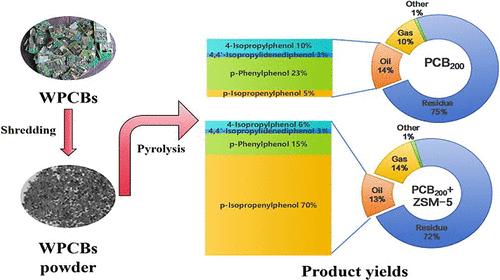Pyrolysis Behavior of Waste Printed Circuit Boards in a Vertical Fixed Bed
IF 3.8
3区 工程技术
Q2 ENGINEERING, CHEMICAL
引用次数: 0
Abstract
Rapid advancements in technology have triggered a substantial decrease in the lifespan of electronic goods, leading to a surge in waste printed circuit boards (WPCBs). Given the recyclable potential of WPCBs’ nonmetallic elements, it is imperative to devise an eco-friendly and cost-effective method for their treatment and recycling. This study delved into optimizing the pyrolysis process of WPCBs in a vertical fixed-bed reactor, examining both catalytic and noncatalytic scenarios. Our findings highlight that catalytic pyrolysis enhances both efficiency and product quality. Optimal conditions emerged with temperatures spanning 500–700 °C, heating rates of 10–20 °C/min, and a 30 min thermostatic time. To further elucidate the composition and structure of the pyrolysis products, Fourier transform infrared spectrometry (FTIR) and gas chromatography–mass spectrometry (GC–MS) analyses were employed. These analyses revealed that catalytic use reduces the yield of liquid and solid byproducts compared to noncatalytic processing. Specifically, the catalyst ZSM-5 facilitated secondary pyrolysis of liquid products, yielding prominent compounds such as 4-isopropyl phenol, p-phenylphenol, 4,4′-isopropylidenediphenol, p-isopropenyl phenol, and 1,2-dimethyl-4-azaphenanthrene-3-carboxylic acid.

废印刷电路板在垂直固定床中的热解行为
技术的飞速发展导致电子产品的寿命大幅缩短,从而导致废弃印刷电路板(WPCB)的激增。鉴于废印刷电路板的非金属元素具有可回收利用的潜力,当务之急是设计一种既环保又经济的方法来处理和回收废印刷电路板。本研究深入探讨了立式固定床反应器中木塑纸板热解工艺的优化问题,同时考察了催化和非催化两种方案。我们的研究结果表明,催化热解可提高效率和产品质量。最佳条件是温度在 500-700 °C 之间,加热速度为 10-20 °C/min ,恒温时间为 30 分钟。为进一步阐明热解产物的组成和结构,采用了傅立叶变换红外光谱法(FTIR)和气相色谱-质谱法(GC-MS)分析。这些分析表明,与非催化处理相比,催化处理可减少液体和固体副产品的产量。具体来说,催化剂 ZSM-5 促进了液体产品的二次热解,产生了一些主要化合物,如 4-异丙基苯酚、对苯基苯酚、4,4′-异亚丙基二苯酚、对异丙烯基苯酚和 1,2-二甲基-4-氮杂菲-3-羧酸。
本文章由计算机程序翻译,如有差异,请以英文原文为准。
求助全文
约1分钟内获得全文
求助全文
来源期刊

Industrial & Engineering Chemistry Research
工程技术-工程:化工
CiteScore
7.40
自引率
7.10%
发文量
1467
审稿时长
2.8 months
期刊介绍:
ndustrial & Engineering Chemistry, with variations in title and format, has been published since 1909 by the American Chemical Society. Industrial & Engineering Chemistry Research is a weekly publication that reports industrial and academic research in the broad fields of applied chemistry and chemical engineering with special focus on fundamentals, processes, and products.
文献相关原料
| 公司名称 | 产品信息 | 采购帮参考价格 |
|---|
 求助内容:
求助内容: 应助结果提醒方式:
应助结果提醒方式:


